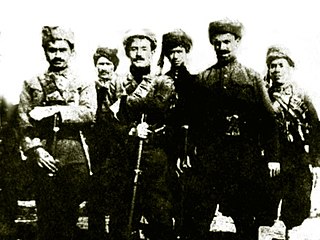Top Qs
Timeline
Chat
Perspective
Republic of Ararat
Kurdish state in the Armenian highlands (1927–1931) From Wikipedia, the free encyclopedia
Remove ads
The Republic of Ararat, also known as the Kurdish Republic of Ararat,[6][7][8][a] was a self-proclaimed Kurdish state from 1927 to 1931. It was located in the Armenian highlands, centred on Karaköse Province. "Agirî" is the Kurdish name for Ararat.[12]
Remove ads
History
Summarize
Perspective
The Republic of Ararat, led by the central committee of Xoybûn party, declared independence on 28 October 1927[5] or 1928,[8][13][14] during a wave of rebellion among Kurds in southeastern Turkey. As the leader of the military was appointed Ihsan Nuri, and Ibrahim Heski was put in charge of the civilian government.
At the first meeting of Xoybûn, Ihsan Nuri Pasha was declared the military commander of the Ararat Rebellion.[15] Ibrahim Heski was made the leader of the civilian administration.[16] In October 1927, Kurd Ava,[1] or Kurdava,[2] a village near Mount Ararat, was designated as the provisional capital of Kurdistan. Xoybûn made appeals to the Great Powers and the League of Nations and also sent messages to other Kurds in Iraq and Syria to ask for co-operation.[17] But under the pressure from Turkey, the British Empire as well as France imposed restrictions on the activities of the members of Xoybûn.[15]
In the spring of 1930, Ferzende Beg visited Ali Can, the leader of the local Kurdish Berazi tribe, and asked him to join the Ararat uprisings.[18] As a result, Ali Can attacked the detachment in the former Karayazı sub-district of Hasankale with his 40 cavalrymen on July 7, 1930, and a 3-month-long rebellion began. After further success, the districts of Tutak, Bulanık, Karaçoban, Köprüköy, Hınıs and Karayazı were annexed to the Ararat State.[18]
The Turkish Armed forces subsequently defeated the Republic of Ararat in September 1931.[19][20]
Remove ads
Flag of the Republic of Ararat

The flag first appeared during the movement for Kurdish independence from the Ottoman Empire and resembles an earlier version created by the Xoybûn (Khoyboun) organization, active in the Ararat rebellion of 1930, and flown by the break-away Republic of Ararat during the period 1927–1931.[citation needed]

Remove ads
See also
References
Wikiwand - on
Seamless Wikipedia browsing. On steroids.
Remove ads



